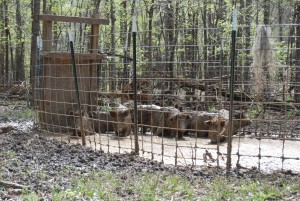By Spenser Bradley
Alabama Extension Agent Specializing In Forestry, Wildlife And Natural Resource Management
Wild hogs are wreaking havoc on landowners in Alabama. The consistent spread and steady population increase presents a problem for both farmers and foresters.
Spenser Bradley, an Alabama Extension agent specializing in forestry, wildlife and natural resource management, said hogs are a growing problem due in part to the difficult nature of hog population control.
Wild Hogs are Difficult to Manage
Bradley said there are several reasons hogs are difficult to manage. The first and biggest reason is because of reproduction.
Domestic pigs were bred to produce big litters, and most of the feral hogs we have now are domestic pigs that have adapted to the wild. Hogs reach sexual maturity in as little as six to 10 months. Litter size is four to 14 piglets, with one to two litters per year.

“Compare that reproduction rate to a deer’s,” Bradley said. “They usually only have one to two fawns per year and do not reach sexual maturity until at least one and a half years old, and often two and a half years old, which means population growth is more gradual.”
Wild hog habits also contribute to their survival. Bradley said their nocturnal nature and generalist habitats make them even more difficult to manage.
Trapping Hogs is an Effective Means of Control
“Setting a trap allows landowners to manage hogs 24/7, without having to be in the woods,” Bradley said. “It also allows you to trap large numbers of hogs. A typical trapping can yield five to 10 hogs, sometimes even 15 to 20. Depending on the size of the property, there will be multiple traps—usually one per 150 acres.”
He said several good trappings could easily remove more than 30 pigs from a given property in short order. Landowners can trap through deer and turkey seasons with proper permits, as opposed to spending hours hunting hogs during the two most popular hunting seasons.
When hunting hogs with a rifle, there may only be time for one or two shots before they scatter. Bradley said in order to keep the pig population stable, 80 percent of the population must be killed. Anything less than 80 percent and the population will continue to increase each year.
Choosing and Setting Traps
Whether pigs have been on the property for many years or several days, Bradley said the best option is to start trapping, as the problem is only going to get worse.
“Follow the pig sign,” he said. “If you find lots of sign near water, that is a good bet. The fresher the sign the better, and do not be afraid to move the traps to better areas. I have never seen a trap set up in a field or food plot that has been successful.”
Bradley said choosing the best trap is a subjective decision, but most trappers agree that a large corral trap with a trap door is the best option.
There are many variations of the corral trap. Some have different style doors, while others have high tech trigger systems that can be set via cell phone. The cheapest option is a guillotine door with a root stick door.